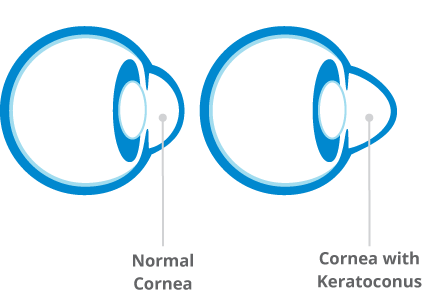For patients with keratoconus or other types of corneal weakening conditions (i.e. pellucid marginal degeneration or ectasia from previous laser vision correction), Valley Eye Associates offers corneal cross-linking to help strengthen the bonds of the cornea.
Corneal Conditions
Keratoconus & Other Cornea Ectasias
The formal medical term for a cornea that is irregularly shaped, unstable, and weak is ectasia. The condition is caused by too few cross-links between the protein fibers (collagen) that make up the cornea, and over time can have a significant impact on your vision.
The most common form of ectasia is keratoconus. In keratoconus, the normally round basketball shape of the cornea (or in the case of astigmatism, a football) becomes cone-shaped and thinner. This results in distorted vision that greatly affects your daily activities. Patients with keratoconus generally begin experiencing symptoms during their late teens or early twenties.
Keratoconus patients usually benefit from cross-linking and its ability to strengthen the bonds that help the cornea hold its shape.
Corneal Ulcers
A corneal ulcer, or keratitis, is an open sore on the cornea that most often is the result of an infection; however, severe dry eye or other eye disorders can also cause this painful condition.
Corneal ulcers can be mistaken for conjunctivitis or pink eye, and while their symptoms do include redness of the eye, discharge, sensitivity to light, and swelling, corneal ulcers can also present with a visible white spot on the front of the eye.
For persistent corneal ulcers, cross-linking can be a safe, effective treatment.
Corneal Cross-Linking
To maintain their strength and rounded shape, your corneas contain cross-links between collagen fibers. Those cross-links function like an invisible meshwork reinforcing your otherwise delicate cornea. Too few cross-links weakens your cornea, causes its shape to change, and leads to distorted vision.
In a corneal collagen cross-linking treatment, drops of riboflavin are applied to the cornea and then “activated” using an ultraviolet light. The activated drops function to create more corneal bonds, making the cornea more resistant to further warping and, in some cases, even restoring a more normal shape. Cross-linking is a minimally invasive treatment that is performed in the clinic.
Valley Eye Associates participated in FDA-sponsored clinical studies of corneal collagen cross-linking in 2010. Our practice continues to be a leader in this field offering several cross-linking options, including epi-on by Peschke and epi-off by Glaukos.
To learn more about corneal cross-linking or other corneal treatment options, please call us at (800) 344‑4443 or fill out our contact form and someone from our office will contact you.


